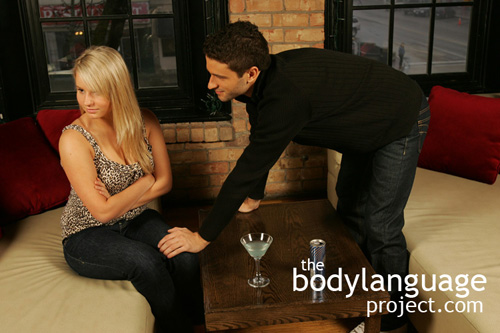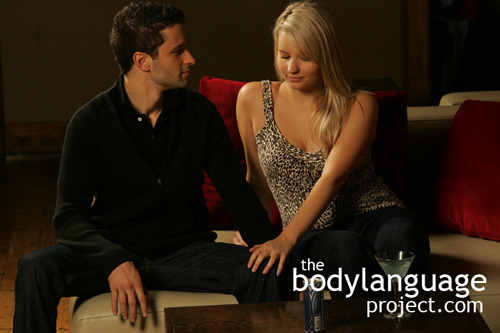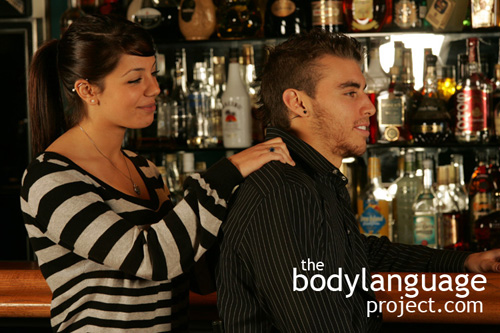Body Language of Touching or Increase In Touching





 Cue: Touching or Increase In Touching.
Cue: Touching or Increase In Touching.
Synonym(s): Increase In Touching, Placing Your Hands On Another, Intentional Touching, Brushing Up Against Someone Intentionally, Touching Intentionally, Touching On Purpose.
Description: Touching between people that suddenly increases, or simply when touching occurs between people.
In One Sentence: Touching or increased touching indicates the desire to create a bond or affiliation in order to receive something, be it material or emotional in nature.
How To Use it: Touch is well researched and has been found to be highly influential when done. Researcher has found that touching can help boost tips, increase the chances of compliance, as well as increase the chances of receiving help. Touching also creates intimacy in relationships from friendships to romantic partners. You should also use touch when you want to strengthen bonds or offer comfort.
Be careful to use touch in appropriate ways. As a general rule, touches further away from the core of the body are more acceptable. For example, touching the forearm or upper arm is more acceptable than touching the torso or small of the back, but in the right circumstances with the right people, this may be acceptable. Touching more intimate such as the breast, buttocks, and genital areas are obviously reserved for sexual relationships. However, in these relationships, can produce high intimacy, though also require a high amount of trust.
A slight touching of a stranger on the upper arm has a very powerful effect on cooperation. The effects of touch have been widely studied. The influence it has on behaviour and requests are conclusive, touching really can help you get what you want from others.
Nonreciprocal touching can serve as a power play between men. For example, in a bar setting, the man who is most at liberty to touch other men will be seen as most dominant, especially if he is not touched in response. This can also work in business where the boss wishes to keep his employees under his leadership.
Context: a) General b) Dating.
Verbal Translation: a) “I’m touching you because I want something from you, want to strengthen our bond, or am sexually interested in you.” a) I’m touching you because I want to comfort you.” b) “I’m touching you because I own you and can do whatever I want.” b) “I’m touching you because I’m sexually interested in you.”
Variant: See Accidental Touching, Head Touch (by others), Touch Reduction.
Cue In Action: a) The boss habitually bumped lightly against the junior manager with a bump of his fist. The gentle tap helped form a bond with him and showed him that they are in agreement and on the right track together.
a) The waitress lightly rubbed her breast up against the patron when reaching for the empty glasses across the table. She had used this technique previously to boost her tips.
b) She lightly brushed off his lapel, as if there was some lint present, then gave him a shoulder massage. Her intensions were becoming obvious to him.
b) She placed her hand over his chest and half hugged him – half rested her head on his shoulder. She did so while making eye contact with the new girl. It was a strong message of ownership.
Meaning and/or Motivation: Territoriality is a big part of the human repertoire. We rarely think about ownership of people, but placing an arm over someone, playfully messing up their hair or guiding them to where we want them to go by placing a hand on their back, as a parent would his child, are just a few ways that we show others that we own and control them.
Touching or an increase in touching likely means that a person is trying to strengthen an affiliation in order to receive something, usually a favour, or create an alliance of some kind. Touching can be a way to offer support and comfort to someone when they are sad or grieving. A mother offering care to her child when they are scared or hurt will often use touch. Alternatively, touching indicates sexual interest in a dating context.
Studies show that touching between men, especially in the workplace, is usually related to power plays and social jostling. An employer will place his hand on the shoulder or back of an employee to reaffirm his status while offering encouragement. Such displays are inappropriate in reverse and wouldn’t usually be tolerated.
Touching between men and women often defines sexual interest. When women touch each other, it is often done out of friendship or to extend sympathy or formulate bonds. When men touch, it signals friendship, but when it is done unilaterally, it signals dominance. Family members also use touching such as hugs and kisses to display affection. The level of touching that people are willing to accept is different from person-to-person. Touch comfort is also highly cultural.
Cue Cluster: Touching has meaning by itself due to its required level of commitment. However, we should also watch for increased proximity and sexual cues to decide how strong the affiliation is intended. The more cues in cluster the stronger the desire to control another person or access them sexually.
Body Language Category: Authoritative body language, Courtship display, Indicators of sexual interest (IOsI), Intimate touching, Liking, Power play, Tie signals.
Resources:
Argo, J. J., Dahl, D. W., & Morales, A. C. (2006). Consumer contamination: How consumers react to products touched by others. Journal of Marketing, 70(April), 81–94.
Aranguren, Martin. “Nonverbal interaction patterns in the Delhi Metro: interrogative looks and play-faces in the management of interpersonal distance.” Interaction Studies. 2016. 16(1) forthcoming.
Aranguren, Martin. “Nonverbal interaction patterns in the Delhi Metro: interrogative looks and play-faces in the management of interpersonal distance.” Interaction Studies. 2016. 16(1) forthcoming.
Aranguren, Martin and Stephane Tonnelat. Emotional Transactions in the Paris Subway: Combining Naturalistic Videotaping, Objective Facial Coding and Sequential Analysis in the Study of Nonverbal Emotional Behavior. Journal of Nonverbal Behavior. 2014. 38:495–521. DOI 10.1007/s10919-014-0193-1
http://bodylanguageproject.com/articles/seriously-stop-touching-use-nonverbal-signaling-manage-unwanted-touching-busy-public
Bailenson, J.N. & Yee, N. (in press). Virtual interpersonal touch: Haptic interaction and copresence in collaborative virtual environments. International Journal of Multimedia Tools and Applications.
Bohm. 1997. Effects of interpersonal touch, degree of justification, and sex of participant on compliance with a request. The Journal of social psychology. 137: 460-469.
Crusco, A. and C. Wetzel. 1984. The midas touch: the effects of interpersonal touch on restaurant tipping, Personality and Social Psychology Bulletin 10: 512–517.
Dickinson, Amy. Block That Hug: The rules on touching children have changed for parents who volunteer as coaches or tutors.(Personal Time/Your Family)(Brief Article). Time. 2000. 155(14): 142.
Debrot, Anik ; Schoebi, Dominik ; Perrez, Meinrad ; Horn, Andrea B. Touch as an interpersonal emotion regulation process in couples’ daily lives: the mediating role of psychological intimacy. Personality & social psychology bulletin. 2013. 9(10): 1373-85.
Derlega, Valerian ; Lewis, Robin ; Harrison, Scott ; Winstead, Barbara ; Costanza, Robert. Gender differences in the initiation and attribution of tactile intimacy. Journal of Nonverbal Behavior. 1989. 13(2): 83-96.
Derlega, Valerian J. ; Catanzaro, Diane ; Lewis, Robin J. Lisak, David (editor). Perceptions About Tactile Intimacy in Same-Sex and Opposite-Sex Pairs Based on Research Participants’ Sexual Orientation. Psychology of Men & Masculinity, 2001, Vol.2(2), pp.124-132
Fisher, J; Rytting, M and Heslin, R. 1976. Hands touching hands: affective and evaluative effects on interpersonal touch, Sociometry 39: 416–421.
Feldman, R., Singer, M.,& Zagoory, O. (2010). Touch attenuates infants’ physiological reactivity to stress. Developmental Science, 13(2), 271–278.
Fromme, Donald ; Jaynes, William ; Taylor, Deborah ; Hanold, Elaine ; Daniell, Jennifer ; Rountree, J. ; Fromme, Marie. Nonverbal behavior and attitudes toward touch. Journal of Nonverbal Behavior. 1989. 13(1): 3-14.
Floyd, Kory. All Touches are not Created Equal: Effects of Form and Duration on Observers’ Interpretations of an Embrace. Journal of Nonverbal Behavior. 1999. 23(4): 283-299.
Guéguen, Nicolas. Nonverbal encouragement of participation in a course: the effect of touching Social Psychology of Education. 2004. 7: 89–98.
http://bodylanguageproject.com/articles/a-touching-way-to-encourage/
Gueguen, Nicolas; Sebastien Meineri and Virginie Charles-Sire. Improving Medication Adherence by Using Practitioner Nonverbal Techniques: A Field Experiment on the Effect of Touch. Journal of Behavioral Medice. 2010. 33:466–473
DOI 10.1007/s10865-010-9277-5
http://bodylanguageproject.com/articles/touching-boosts-compliance-improving-medical-compliance-using-nonverbal-communication/
Guéguen, N. (2001a). Toucher et soumission a` une requeˆte: Re´plications expe´rimentales en situation naturelle et e´valuation de l’impact du statut. Revue Internationale de Psychologie Sociale. 2001(a). 14(3):113-158.
Guéguen, N. (2001b). L’effet d’influence du toucher sur le comportement du consommateur: 2 illustrations expe´rimentales en exte´rieur. Direction et Gestion: La Revue des Sciences de Gestion. 2001(b). 190–191, 123–132.
Guéguen, N and C. Jacob 2006, Touch and consumer behavior: A new experimental evidence in a field setting, International Journal of Management 23: 24–33.
Guéguen, N., & Jacob, C. The effect of touch on tipping: An evaluation in a French’s bar. International Journal of Hospitality Management. 2005. 24(2): 295-299.
Gueguen, Nicolas; Celine Jacob; Gaelle Boulbry. The Effect of Touch on Compliance With a Restaurant’s Employee Suggestion. Hospitality Management. 2007. 26: 1019-1023.
http://bodylanguageproject.com/articles/touching-leads-compliance-study/
Guéguen, N. (2007). Courtship compliance: The effect of touch on women’s behavior. Social Influence, 2, 81-97.
Gueguen, Nicolas. The effect of a woman’s incidental tactile contact on men’s later behavior.(Report). Social Behavior and Personality: an international journal. 2010. 38(2): 257(10).
Guéguen, Nicolas. Nonverbal encouragement of participation in a course: the effect of touching Social Psychology of Education. 2004. 7: 89–98.
http://bodylanguageproject.com/articles/a-touching-way-to-encourage/
Gulledge, Andrew K ; Stahmann, Robert F ; Wilson, Colwick M. Seven types of nonsexual romantic physical affection among Brigham young university students
Psychological reports 2004, Vol.95(2), pp.609-14
Gulledge, Andrewk. ; Gulledge, Michelleh. ; Stahmannn, Robertf. Romantic Physical Affection Types and Relationship Satisfaction. The American Journal of Family Therapy, 2003, Vol.31(4), p.233-242
Gurevitch, Z. D. The Embrace: On the Element of Non-Distance in Human Relations. The Sociological Quarterly. 1990. 31(2): 187-201.
Greenbaum, Paul ; Rosenfeld, Howard. Varieties of touching in greetings: Sequential structure and sex-related differences. Journal of Nonverbal Behavior. 1980. 5(1): 13-25.
Heino, William J. Perfect Timing for Parental Hugs.(to comfort children following medical treatment)(Brief Article). Consultant. 2000. 40(13): 2173.
Hadi, Rhonda ; Valenzuela, Ana. A meaningful embrace: Contingent effects of embodied cues of affection. Journal of Consumer Psychology, 2014, Vol.24(4), pp.520-532
Hugs help protect against stress and infection, say Carnegie Mellon researchers.(Report)
Health & Medicine Week, Jan 2, p.1341
Hall, Jeffrey A. and Chong Xing. The Verbal and Nonverbal Correlates of the Five Flirting Styles. Journal of Nonverbal Behavior. 2015. 39:41–68. DOI 10.1007/s10919-014-0199-8
http://bodylanguageproject.com/articles/first-12-minutes-flirting-using-nonverbal-communication-study-reveals-26-body-language-cues-attraction/
Hadi, R., and Valenzuela, A., A meaningful embrace: Contingent effects of embodied cues of affection. Journal of Consumer Psychology. 2014. http://dx.doi.org/10.1016/j.jcps.2014.02.001
http://bodylanguageproject.com/articles/whats-in-a-nonverbal-object-caress/
Hertenstein, Matthew J; Keltner, Dacher; App, Betsy; Bulleit, Brittany A; Jaskolka, Ariane R 2006. Touch Communicates Distinct Emotions. Emotion. 6(3): 528-533
Hazan, C., & Shaver, P. (1987). Romantic love conceptualized as an attachment process. Journal of Personality and Social Psychology, 52, 511–524.
Jeffrey D. Fisher; Marvin Rytting; Richard Heslin. 1976. Hands Touching Hands: Affective and Evaluative Effects of an Interpersonal Touch. Sociometry, 39(4): 416-421.
Krishna, A., & Morrin, M. (2008). Does touch affect taste? The perceptual transfer of product container haptic cues. Journal of Consumer Research, 34(6), 807–818.
Kleinke, C. Compliance to Requests Made by Gazing and Touching Experimenters in Field Settings. Journal of Experimental Social Psychology. 1977. 13: 218–223.
Kammers, Marjolein P.M. ; de Vignemont, Frédérique ; Haggard, Patrick. Cooling the Thermal Grill Illusion through Self-Touch. Current Biology. 2010. 20(20): 1819-182.
Kaufman, D. and J. Mahoney. 1999 The effect of waitresses’ touch on alcohol consumption in dyads, The Journal of Social Psychology 139: 261–267.
Kneidinger, L. M.; Maple, T. L.; Tross, S. A. 2001. Touching behavior in sport: functional components, analysis of sex differences, and ethological considerations. Journal of Nonverbal Behavior, 25(1): 43-62.
Lee Ann Renninger, T. Joel Wade, Karl Grammer. Getting that female glance: Patterns and consequences of male nonverbal behavior in courtship contexts. Evolution and Human Behavior. 2004; 25: 416–431.
http://bodylanguageproject.com/articles/part-i-how-to-read-male-sexual-body-language-a-study-for-women-and-the-men-who-wish-to-cheat-the-system/
Lynn et al., 1998 M. Lynn, J.M. Le and D. Sherwyn. 1998. Reach out and touch your customers, Cornell Hotel and Restaurant Administration Quaterly 39: 60-65
Larsen, Knuds. ; Leroux, Jeff. A study of same sex touching attitudes: Scale development and personality predictors. Journal of Sex Research. 1984. 20(3): 264-278.
Moszkowski, Robin J. ; Stack, Dale M. ; Girouard, Nadine ; Field, Tiffany M. ; Hernandez-Reif, Maria ; Diego, Miguel. Touching behaviors of infants of depressed mothers during normal and perturbed interactions. Infant Behavior and Development. 2009. 32(2): 183-194.
Maclaren, Kym. Touching matters: Embodiments of intimacy. Emotion, Space and Society. 2014. 13: 95-102.
Madden, Myron. Meaningful pastoral intimacy. Pastoral Psychology. 1976. 25(1): 34-38.
Maclaren, Kym. Touching matters: Embodiments of intimacy. Emotion, Space and Society. 2014. 13: 95-102.
Moore, Monica. Courtship Signaling and Adolescents: Girls Just Wanna Have Fun. Journal of Sex Research. 1995. 32(4): 319-328.
http://bodylanguageproject.com/articles/girls-just-want-to-have-fun-the-origins-of-courtship-cues-in-girls-and-women/
Moszkowski, Robin J. ; Stack, Dale M. ; Chiarella, Sabrina S. Infant touch with gaze and affective behaviors during mother–infant still-face interactions: Co-occurrence and functions of touch. Infant Behavior and Development. 2009. 32(4): 392-403.
Maclaren, Kym. Touching matters: Embodiments of intimacy. Emotion, Space and Society. 2014. 13: 95-102.
Nelson, Holly ; Geher, Glenn. Mutual Grooming in Human Dyadic Relationships: An Ethological Perspective. Current Psychology. 2007. 26(2): 121-140.
Navarro, Joe. 2008. What Every BODY is Saying: An Ex-FBI Agent’s Guide to Speed-Reading People. William Morrow Paperbacks.
Nannberg, J., & Hansen, C. Post-compliance touch: An incentive for task performance. The Journal of Social Psychology. 1994.134, 301–307.
Peck, J., & Shu, S. B. (2009). The effect of mere touch on perceived ownership. Journal of Consumer Research, 36(Oct), 434–447.
Peck, J., & Wiggins, J. (2006). It just feels good: Consumers’ affective response to touch and its influence on persuasion. Journal of Marketing, 70(Oct), 56–69.
Paulsell, Shari ; Goldman, Morton. The Effect of Touching Different Body Areas on Prosocial Behavior. The Journal of Social Psychology. 1984. 122(2): 269-273.
Remland, Martins. ; Jones, Tricias. ; Brinkman, Heidi. Interpersonal Distance, Body Orientation, and Touch: Effects of Culture, Gender, and Age. The Journal of Social Psychology. 1995 135(3): 281-297.
Rabinowitz, Fredric E. The male-to-male embrace: breaking the touch taboo in a men’s therapy group. Journal of Counseling and Development. 1991. 69(6): 574(3).
R. Stephen and R. Zweigenhaft. 1986. The effect on tipping of a waitress touching male and female customers. The Journal of Social Psychology 126 pp. 141–142.
Smith, D. E., Gier, J. A., & Willis, F. N. 1982. Interpersonal touch and compliance with a marketing request. Basic and Applied Social Psychology. 3: 35-38.
Toronto, Ellen L.K. A clinician’s response to physical touch in the psychoanalytic setting. International Journal of Psychotherapy. 2002 7(1): 69-81.
Tracy, R. L., & Ainsworth, M. D. S. (1981). Maternal affectionate behavior and infant-mother attachment patterns. Child Development, 52, 1341-1343.
Taavoni, S ; Shahali, S ; Haghani, H. Infant Vaccination Pain Management: Comparing the Effect of Mother’s Hug and Breast Feeding, Tehran, 2009-2010. Pediatric Research. 2011. 70: 738-738.
Thompson, Erin H. and James A. Hampton. The Effect of Relationship Status on Communicating Emotions Through Touch,. Cognition and Emotion. 2011. 25(2): 295-306. DOI: 10.1080/02699931.2010.492957.
http://bodylanguageproject.com/articles/using-touch-convey-emotion
Takeuchi, Mika ; Miyaoka, Hitoshi ; Tomoda, Atsuko ; Suzuki, Masao ; Liu, Qingbo ; Kitamura, Toshinori. The Effect of Interpersonal Touch During Childhood on Adult Attachment and Depression: A Neglected Area of Family and Developmental Psychology? Journal of Child and Family Studies. 2010. 19(1): 109-117.
Williams. 1993. Effects of Mutual Gaze and Touch on Attraction, Mood, and Cardiovascular Reactivity Source: Journal of Research in Personality. 27(2): 170-183.
Williams, L. E., Huang, J. Y., & Bargh, J. A. (2009). The scaffolded mind: Higher mental processes are grounded in early experience of the physical world. European Journal of Social Psychology, 39, 1257–1267.
Willis, F. N., & Hamm, H. K. 1980. The use of interpersonal touch in securing compliance. Journal of Nonverbal Behavior. 5: 49-55.
Willis, Frank N. , Jr. ; Dodds, Rebecca A. Age, relationship, and touch initiation. The Journal of Social Psychology. 1998. 138(1). 115(9).
Werner, Carol ; Brown, Barbara ; Damron, Gary Steiner, Ivan D. (editor). Territorial marking in a game arcade. Journal of Personality and Social Psychology. 1981. 41(6): 1094-1104.
